Nokia Lumia 735 Review
by Brett Howse on February 3, 2015 6:00 AM EST- Posted in
- Smartphones
- Microsoft
- Nokia
- Lumia
Display
Smartphone displays are one of the most important features of any device. It is the prime method of interaction, it provides information, and for a lot of people, it is their window into the world. We put a lot of testing into displays because of their importance. The Lumia brand contains both Liquid Crystal Displays (LCD) and Organic Light Emitting Diode (OLED) panels depending on the model, and in the case of the Lumia 735 it has a 1280x720 resolution OLED in an RGBG format. While not as high resolution as many flagships today, the 4.7 inch display still packs in 316 pixels per inch, so based on that number alone it should be fairly sharp.
Lumia displays often pack in extra features as well, and the Lumia 735 is no exception. The protective outer shell is Corning Gorilla Glass 3, which has an “Easy to Clean” coating on top. The lower end Lumia phones lack this coating, and it can give them a surface with too much grip, making it difficult to move your finger around smoothly. Thankfully the Lumia 735 has no such issues. Nokia added ClearBlack to most of their models, and the Lumia 735 does have this polarizer to help with outdoor visibility and improve black levels. Another feature of many Lumia phones is the Super Sensitive Touch which allows the display to be used with gloves on – a boon when you live in colder climates or on Hoth. It also features the same Sunlight Readability Enhancements as other Lumia models such as the 930, which is content-adaptive backlight control software called Assertive Display from Apical. This makes the screen much easier to use outdoors, as this image from our Lumia 930 review shows.
Sunlight Readbility Off (upper picture) vs On (lower picture)
To test the displays characteristics and accuracy, we turn to SpectralCal’s CalMAN 5 software suite with a custom workflow. The X-Rite i1Pro Spectrophotometer is used to test color accuracy, and the X-Rite i1Display Pro colorimeter is used for contrast ratios and brightness. Since this is an OLED display, we generally ignore contrast ratios and black levels due to the black level of OLED being zero, meaning the contrast ratio for OLED displays is infinite. I once tried to graph infinity but it did not go over well.

At about 300 nits, the brightness of the display is on the low end. This is fairly common with OLED displays, and high white levels can be a real strain on the battery. LCD panels can generally have higher brightness levels, although at the expense of true black, so as always, this is a compromise. The Sunlight Readability Enhancements and ClearBlack polarizer do help with outdoor viewing though, and I never had any issues using it outside.
The white point and grayscale accuracy of the Lumia 735 is very good. Greens get a bit high in the middle of the range, but overall a dE value of 3.01 along with a white point close to 6505K makes this panel a lot better to use than older OLED, which tended to have a very blue cast to it.
Moving on to the saturation sweep, we can see the Lumia 735 is not as accurate with colors as it is with grayscale. Measuring to sRGB, you can see that the panel is oversaturated on all of the colors, which once again is a tendency of OLED displays. It does hit the entire sRGB gamut though, which is something that we still do not see on many notebook computers. The saturations are not terrible, but they are far from perfect.
We can see that in our colorchecker test, the good grayscale helps the poor saturation sweep in the overall result. It is a better result than the Lumia 930 gave, but we want to see values under 3 if possible. When I originally tested the Lumia 630, I was pretty amazed at the display accuracy and hoped that it would continue with the other Lumia reviews, but that has not been the case.
The debate about OLED vs LCD may never end, but we have seen some accurate OLED displays in the past year. The Lumia 735 is not a terrible display by any means, and has a good white point and solid grayscale performance. Brightness could be a bit higher for outdoor use, but with the other display features I never found it to be a chore to use it outside. The OLED display shines in any sort of use case where darker subject matter is being displayed, since the LCD has always had poor performance with dark scenes.




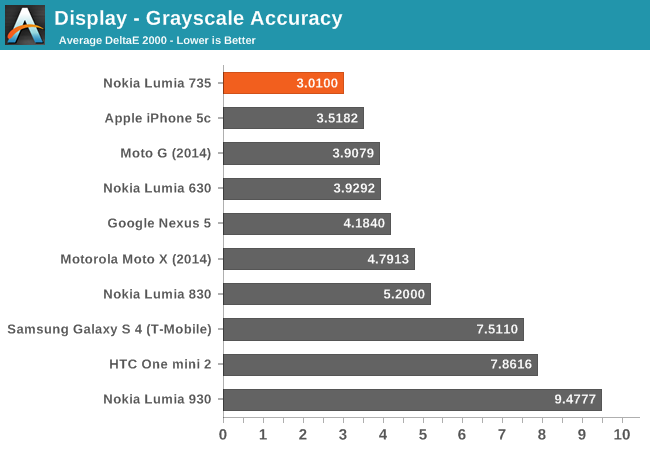
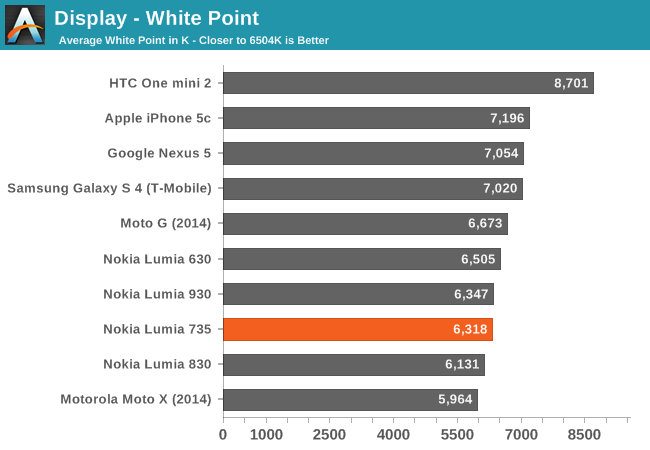

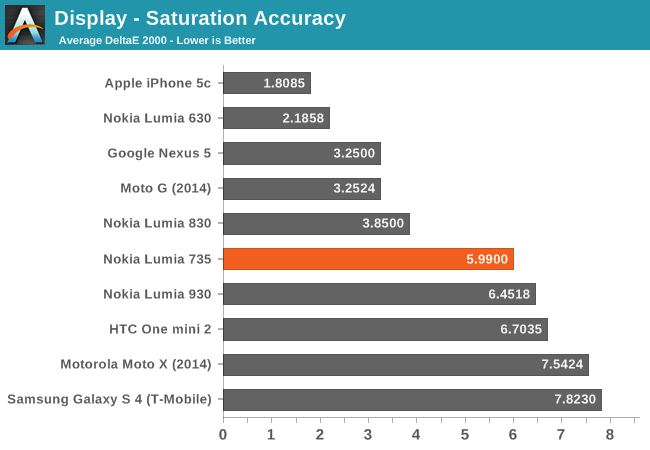

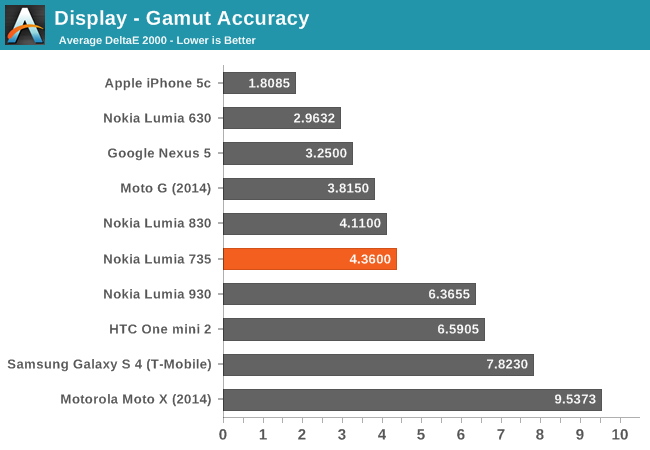

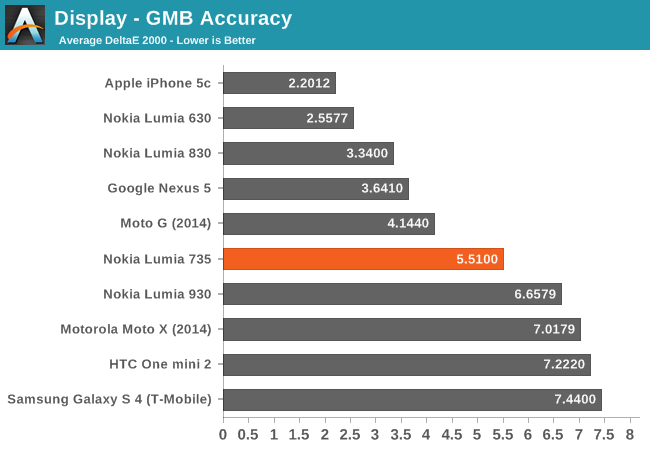








64 Comments
View All Comments
Brett Howse - Tuesday, February 3, 2015 - link
The Glance screen app is only available to phones with the correct hardware to use it unfortunately. Would be nice if it was just an app.noblemo - Friday, February 13, 2015 - link
The slow Wi-Fi means disabling your 5GHz radio or upgrading to an access point with simultaneous 2.4/5GHz coverage. I ran into this issue when I bought a Lumia 635 as a house phone. Now I have to run my laptop and Icon on congested 2.4GHz when no one else in the area is running 5GHz. First World problem, but still annoying.nathanddrews - Tuesday, February 3, 2015 - link
In all honesty, I'm waiting to upgrade my S3 to an Intel-X86-powered, Windows 10 phone. We're almost there.http://makeameme.org/media/created/almost-there-al...
juan96 - Tuesday, February 3, 2015 - link
For display test, I know that Anandtech uses Calman SW and i1Pro for measuring . But I curious, how they input test pattern to cell phone? As anybody knows, MicroUSB port of cellphone is output only.deltaman - Tuesday, February 3, 2015 - link
Actually, Lumia phones DO support transferring data in BOTH directions via the micro USB port; the phone mounts like any other USB storage device when connected to a Windows machine, & M'soft offers a free utility for file transfers to/from Mac OS devices...juan96 - Tuesday, February 3, 2015 - link
Yes, I misunderstood. MicroUSB is not only for output. But I still didn't find the solution to use Android tablet uses as display device like monitor.tipoo - Tuesday, February 3, 2015 - link
With 720p and MicroSD thrown in, it could be a decent Moto G competitor. I wish they at least upgraded to the Snapdragon 410 though.tipoo - Tuesday, February 3, 2015 - link
It's pretty silly how poorly the WP browser does against the equivalent SoC in an Android phone. Sunspider is the only thing it does well in, and we know Microsoft targeted that for optimizations, making it less of a real world result. They don't even have a terrible rendering engine on the desktop side, so I don't get why they continue to underperform so much on the mobile side.tipoo - Tuesday, February 3, 2015 - link
And the GPU too, what is with that?Brett Howse - Tuesday, February 3, 2015 - link
This will finally be resolved when Spartan is the new browser in Windows Phone 10. Not that this is any excuse for the poor implementation now, but finally, browser performance seems to be a priority.